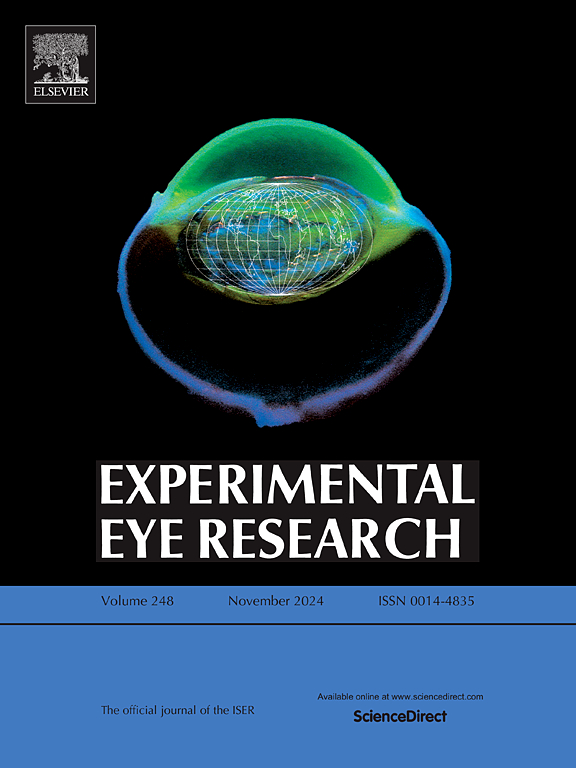油酸与原发性闭角型青光眼的关系:代谢组学的发现
IF 3
2区 医学
Q1 OPHTHALMOLOGY
引用次数: 0
摘要
近年来,代谢组学已被用于眼科疾病的研究。然而,关于原发性闭角型青光眼(PACG)的代谢组学研究却很少报道。本研究的目的是探索一种两步代谢组学分析方法,以识别PACG患者房水中的差异代谢物。从20例年龄相关性白内障、急性PACG和慢性PACG患者中收集房水样本。在第一步中,使用非靶向代谢分析鉴定变化的代谢物。第二步,选择急性和慢性PACG组中表现出一致变化的代谢物进行靶向代谢分析。进一步,进行相关性分析,研究差异代谢物与临床数据之间的相关性。结果表明,使用非靶向代谢组学方法鉴定了7495种代谢物;随后,在PACG组中选择7种变化一致的代谢物,包括氧己二酸、庚酸、油酸、喹啉酸、25-羟基胆固醇、甘露醇和马来酸。除喹啉酸外,其他代谢物采用靶向代谢组学分析鉴定。但为避免临床药物偏倚,我们将甘露醇和马来酸排除在进一步的统计分析之外。PACG组具有较高的油酸和氧己二酸含量的趋势,只有油酸与性别和最小分辨视力角度的对数呈负相关。这些发现不仅提示油酸可能参与了PACG眼部病变的发展,也为其他临床疾病鉴别差异代谢物提供了一种方法。本文章由计算机程序翻译,如有差异,请以英文原文为准。
Oleic acid association with primary angle-closure glaucoma: A finding using metabolomics
Metabolomics has been used to study ophthalmic diseases for the past several years. However, there was rare metabolomics study was reported about primary angle-closure glaucoma (PACG). The purpose of this study was to explore a two-step metabolomics analysis method for identifying differential metabolites in the aqueous humor of patients with PACG. Aqueous humor samples were collected from 20 patients each with age-related cataracts, acute PACG, and chronic PACG. In the first step, the changed metabolites were identified using a non-targeted metabolic analysis. In the second step, metabolites showing consistent changes in both acute and chronic PACG groups were selected for targeted metabolic analysis. Further, correlation analysis was performed to study the correlation between differential metabolites and clinical data. The results demonstrated that 7495 metabolites were identified using non-targeted metabolomics methods; subsequently, seven consistently changed metabolites, including oxoadipic acid, heptanoic acid, oleic acid, quinolinic acid, 25-hydroxycholesterol, mannitol, and maleic acid, were selected in the PACG groups. Except for quinolinic acid, the other metabolites were identified using targeted metabolomics analysis. However, to avoid clinical drug bias, mannitol and maleic acid were excluded from further statistical analyses. The PACG groups showed a tendency towards higher oleic acid and oxoadipic acid contents, whereas only oleic acid was negatively correlated with sex and logarithm of the minimum angle of resolution vision. These findings not only indicate that oleic acid may be involved in the development of pathological changes in eyes with PACG but also provide a method for identifying differential metabolites for other clinical diseases.
求助全文
通过发布文献求助,成功后即可免费获取论文全文。
去求助
来源期刊

Experimental eye research
医学-眼科学
CiteScore
6.80
自引率
5.90%
发文量
323
审稿时长
66 days
期刊介绍:
The primary goal of Experimental Eye Research is to publish original research papers on all aspects of experimental biology of the eye and ocular tissues that seek to define the mechanisms of normal function and/or disease. Studies of ocular tissues that encompass the disciplines of cell biology, developmental biology, genetics, molecular biology, physiology, biochemistry, biophysics, immunology or microbiology are most welcomed. Manuscripts that are purely clinical or in a surgical area of ophthalmology are not appropriate for submission to Experimental Eye Research and if received will be returned without review.
 求助内容:
求助内容: 应助结果提醒方式:
应助结果提醒方式:


